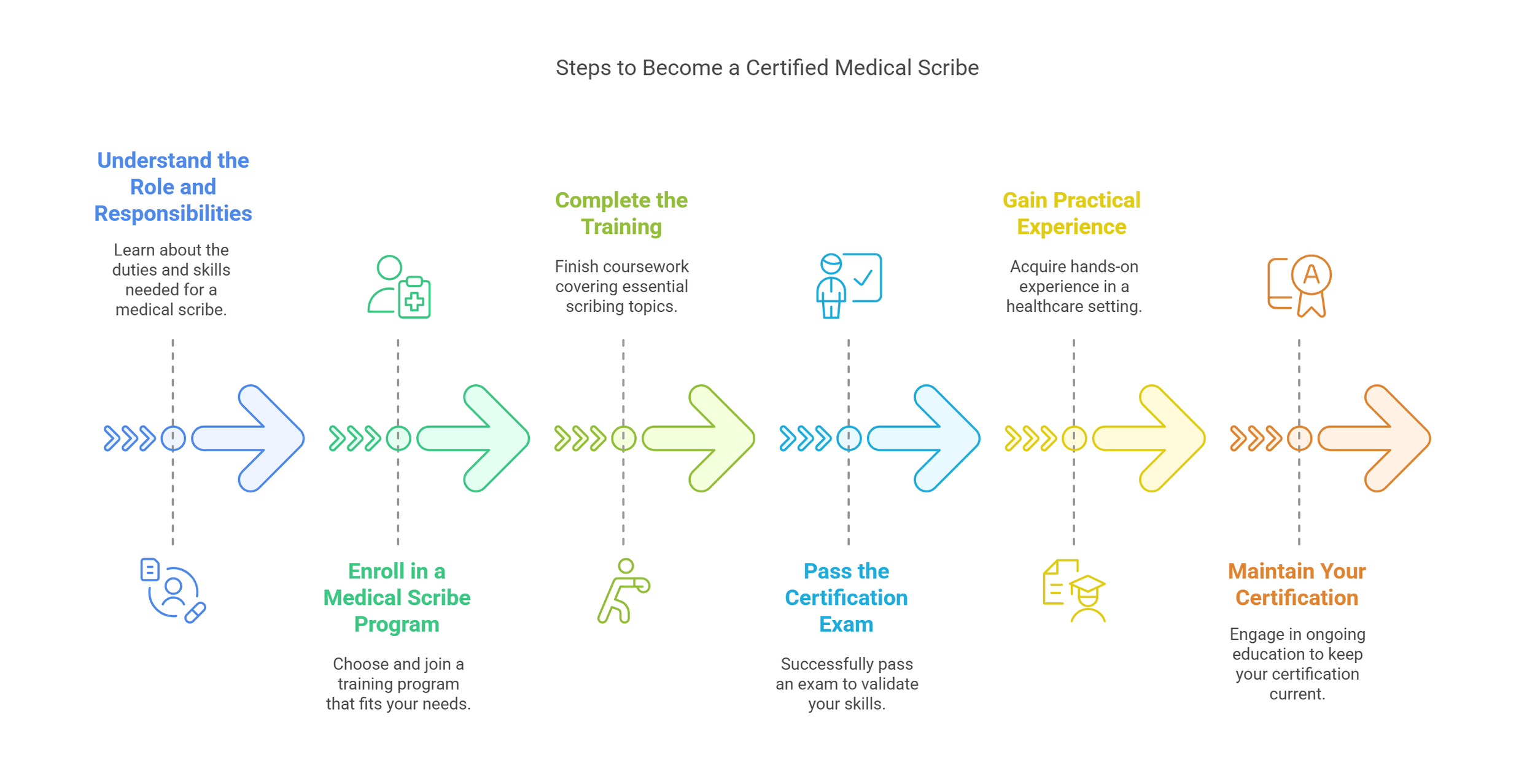How Long Does It Take to Become a Certified Medical Scribe?
Becoming a certified medical scribe is an appealing career option for many individuals interested in healthcare. If you're considering this path, one of the most common questions is: How long does it take to become a certified medical scribe? The timeline varies based on a few factors, including the program you choose, the level of certification you're pursuing, and how much time you can dedicate to studying and completing the program.
In this blog post, we’ll break down the steps to becoming a certified medical scribe, the average time it takes, and some additional factors that can influence the process. Let’s dive in!
What is a Medical Scribe?
A medical scribe is a trained professional who assists healthcare providers by documenting patient encounters in real time. They record essential details, such as medical histories, symptoms, diagnoses, and treatment plans, which help in maintaining accurate medical records. By managing documentation, medical scribes allow healthcare providers to focus on patient care rather than administrative tasks. Scribes are essential in fast-paced medical settings like hospitals and clinics, contributing to improved efficiency and accuracy in the healthcare process. Their role enhances the overall patient experience and ensures that medical professionals can deliver high-quality care.
Steps to Become a Certified Medical Scribe
Understand the Role and Responsibilities Before pursuing certification, it’s important to understand what being a medical scribe entails. Your primary responsibility will be to document patient visits and medical information during consultations. You will work alongside doctors, nurses, and other healthcare staff to maintain accurate records in real-time. Scribes also need to be familiar with medical terminology, health conditions, and healthcare procedures. This will help them ensure that the documentation is precise and aligns with the medical language used in clinical settings.
Enroll in a Medical Scribe Program The next step is to choose a medical scribe training program that best suits your needs. These programs teach you the necessary skills, including medical terminology, anatomy, and healthcare documentation systems. Programs may be offered online or in person, and the length of these courses can vary from several weeks to a few months. Many institutions offer self-paced options, allowing you to complete your studies based on your own schedule. Some programs also offer hands-on training, where you’ll gain practical experience using Electronic Health Record (EHR) systems.
Complete the Training After enrollment, you’ll need to complete the training coursework, which will cover essential topics like medical terminology, anatomy, and specific protocols related to medical scribing. Some programs include clinical rotations or real-world practice to ensure that you’re ready to handle the demands of a medical environment. This training is crucial for building a foundation in medical documentation and understanding patient care processes. Upon successful completion of the program, you will have the knowledge to take the certification exam.
Pass the Certification Exam Once you’ve completed your training, you’ll need to pass a certification exam. Certification is not mandatory in all areas, but it is highly beneficial for career advancement. The exam typically covers topics like medical terminology, healthcare systems, and scribing best practices. Two well-known certification bodies are the American Healthcare Documentation Professionals Group (AHDPG) and the Association of Medical Scribe Specialists (AMSS). Passing this exam validates your skills and demonstrates your readiness to work as a certified medical scribe.
Gain Practical Experience While some individuals may find employment directly after completing their certification, others may need to gain practical experience through internships or entry-level positions. Practical experience in a healthcare setting is invaluable because it allows you to apply the knowledge you've gained in a real-world environment. Some employers may require a certain number of hours or specific tasks to be completed before officially hiring a medical scribe.
Maintain Your Certification Once you’re certified, it's important to maintain your certification. Most organizations require continuing education and periodic recertification. You may need to take courses or complete additional training every 2-3 years to stay up-to-date with the latest healthcare practices and technologies. This ongoing education ensures that certified medical scribes remain proficient in their roles and continue to provide valuable support to healthcare providers.
Average Time to Become a Certified Medical Scribe
The overall time it takes to become a certified medical scribe can vary but generally ranges from 6 months to a year. It depends on factors like whether you're attending a full-time or part-time program, the complexity of the course, and how quickly you can complete the certification exam. Most training programs last between 3 to 6 months, and you may need additional time for studying and gaining practical experience. The process can take longer if you're pursuing certifications or work experience after your training, but the timeline is manageable for those dedicated to entering the medical field.
Factors That Affect the Time to Certification
Program Type The type of training program you choose can significantly impact how quickly you can become a certified medical scribe. Online courses, especially self-paced ones, tend to offer more flexibility, allowing you to move through the material at your own pace. In-person programs might have set schedules, which could extend the length of time needed to finish the training. Depending on whether you attend a full-time or part-time program, the overall timeline can differ.
Study Time The amount of time you dedicate to studying will also influence how fast you can complete your certification. Some individuals may grasp medical terminology and healthcare concepts more quickly, while others may need more time to learn the material. Setting aside dedicated study time and staying disciplined will help speed up the process and ensure you are well-prepared for your certification exam.
Previous Experience If you have prior experience in healthcare, such as working as a medical assistant, administrative assistant, or even volunteering in a medical setting, you may already be familiar with many of the concepts you will encounter in a scribe program. This background can help shorten the training time, as you'll be able to focus on the parts of the program that are new to you rather than reviewing basics you already know.
Employer Requirements Some employers may have additional requirements that can extend the time it takes to become a certified medical scribe. This might include specific certifications, practical training hours, or experience in a clinical setting before you can start working. These factors should be considered when planning how long it will take to complete the process.
Conclusion
Becoming a certified medical scribe typically takes between 6 months to 1 year, depending on the program type, study time, and work experience. If you're ready to start your career as a medical scribe, consider choosing a reputable certification provider like ACMSO, which offers comprehensive programs to help you succeed. At ACMSO, we provide medical scribe certifications that can equip you with the skills and knowledge necessary for a rewarding career in healthcare documentation.
Lesser-Known Facts About Medical Scribing
Medical scribes contribute to better doctor-patient interactions by allowing healthcare providers to focus more on patient care rather than spending time on paperwork. The American Health Information Management Association (AHIMA) highlights the importance of scribe roles in enhancing healthcare delivery.
The scribe profession is growing rapidly due to the increasing demand for healthcare professionals who can help manage medical documentation efficiently. The U.S. Bureau of Labor Statistics provides insights into the growing demand for medical records professionals, including scribes.
Specialized scribe roles exist in fields like dermatology, emergency care, and orthopedics, requiring a deeper understanding of specific medical procedures. For instance, Dermatology Scribe roles require knowledge of skin conditions and treatments.
Becoming a medical scribe can lead to advanced career paths in healthcare, such as becoming a physician assistant or pursuing further medical education. The Physician Assistant Education Association (PAEA) offers resources for those looking to pursue a physician assistant career.
The medical scribe profession dates back to the 1960s, and it was originally designed to alleviate the paperwork burden for doctors in busy hospitals. History of the Medical Scribe provides a detailed look at the development of scribing.
Scribes often work with Electronic Health Record (EHR) systems, gaining expertise in these systems, which are valuable for many other roles in healthcare administration. The Office of the National Coordinator for Health Information Technology (ONC) offers resources on the use of EHRs in healthcare.
Remote scribe jobs are on the rise, giving healthcare providers the flexibility to hire scribes who can work from home. FlexJobs lists remote job opportunities, including for medical scribes.
Medical scribes are needed in a variety of healthcare settings, including hospitals, clinics, urgent care centers, and private practices. According to ScribeAmerica, one of the leading medical scribe companies, scribes are vital in improving workflow in various medical environments.
Scribing can reduce burnout among healthcare professionals by offloading the administrative burden. A study published by JAMA explores how scribes help reduce physician burnout by managing documentation tasks.
The average salary for a medical scribe in the U.S. can vary based on experience, location, and setting, but it generally ranges from $30,000 to $40,000 annually. PayScale provides salary data and trends for medical scribes.
FAQs
-
Enroll in an online self-paced program, focus on completing the coursework efficiently, and take the certification exam as soon as you finish your training.
-
No, a degree is not required to become a medical scribe. However, some background in healthcare or related fields may help.
-
Certification programs can range from $500 to $2,000, depending on the provider and the type of program.
-
While certification is not always mandatory, many employers prefer certified medical scribes due to the specialized skills they bring to the role.
-
Most medical scribe certifications require renewal every 2 to 3 years, which may involve continuing education and passing a recertification exam.





